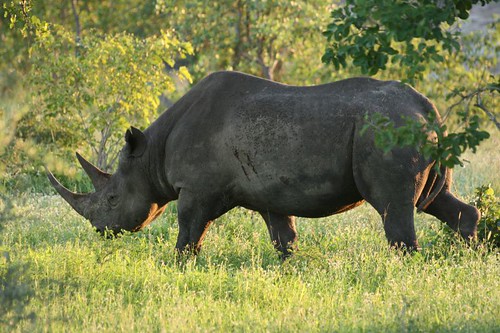The alarming decline of Black Rhino population in South Africa

“Black rhino” (CC BY-NC 2.0) by 5particle
The Black Rhinoceros (Diceros Bicornis) is a critically endangered mammal living in the high grasslands of South Africa, Botswana, Kenya, Malawi, Namibia, Swaziland, Mozambique, Tanzania, Namibia and Zimbabwe. South Africa is currently experiencing a drastic escalation of poaching and illegal wildlife trafficking, endangering this species by massive population losses since 2008; leading to the worrying fact that, black rhinos have today found themselves on the IUCN red list as critically endangered species.
Rhino poaching is the illegal hunting of rhinoceros in Africa, primarily because on an increased demand of a traditional Chinese medicine, made from rhino horn. This activity exploded in 2008 and has been tragically growing ever since.
South Africa is the habitat of the largest population of black rhinoceros amongst all of the African nations. The famous Kruger National Park (KNP) is 19,633 squared kilometres and home to 8,000-9,000 rhinos, however leading it to be amongst the largest poaching targets of Africa, due to its high numbers in the hunted species. (Rhino Poaching Statistics)
As seen above, data between the 1990s to the 2000s show very low interest in poaching of rhinoceros horn as either a trophy or a form of medicine, thought to be able to cure cancer and hangovers, demanded by the Asian market.

Lea. 2017. “Black rhino deaths in three different parks.” Data source: Rhino Poaching Statistics
As of 2008, South Africa’s Department of Environmental Affairs and the South African National Parks (SAN Parks) saw a substantial increase in horn hunting activities in public national parks and private reserves all through the country. This increase escalated dramatically, especially in the Kruger National Park and other major tourist attractions, experiencing a total death rate of 5208 rhinos; this being a 97.6% poaching increase since December 1990.
The Kruger National Park experienced a drastic increase in rhino poaching because of the increased demands of rhino horn by the Asian market.
When looking at the blue graph line, representing the total amount of losses due to poaching between 2008 to 2014 of the Kruger National Park, one is able to see the drastic increase as their numbers rose from 36 losses in 2008 to 826 losses in 2014.
The unarmed guards who were on duty between 2008 and 2014 are an explanation of the number of losses. Further, the escalating numbers also have to do with two other major factors. These include, the video cameras not being exposed well-enough, thus not being able to track down hunters. This making it clearly easier for these to come back and do some more poaching without the threat of being caught and the constant improvement of poacher’s technology used to hunt down the poor animals.
When looking at the orange and red line, representing Limpopo National Park and the Mpulanga reserve, their rate of increase is very similar as they experienced a similar story. From 2008, up to 2011 the number of losses slowly increased by 29 kills for Mpulanga and 22 for LMPO. This is due to a constant challenge between the national parks and the poachers; as when the parks increased their efficiency in cameras, the poaching teams increased their discretion and when the parks increased their safety by introducing the military during day time, poachers increased their night visibility to kill the animals at night. This relationship therefore explains the constant increase and decrease of poaching in these two tourist attractions, also being the habitat of the extremely endangered species.
However, there is good news regarding the challenge to avoid their extinction, as the South African government demanded to introduce military forces in order to protect the wildlife, to conserve their land, educate the public and provide nocturnal camera security in order to sentence the recognised poachers. Further methods such as horn poisoning has also been introduced, as explained in the following video:
Earthtouch. “Poisoning Horns to save Rhinos | Earth Touch Insider.” YouTube. 05 Feb. 2014.
